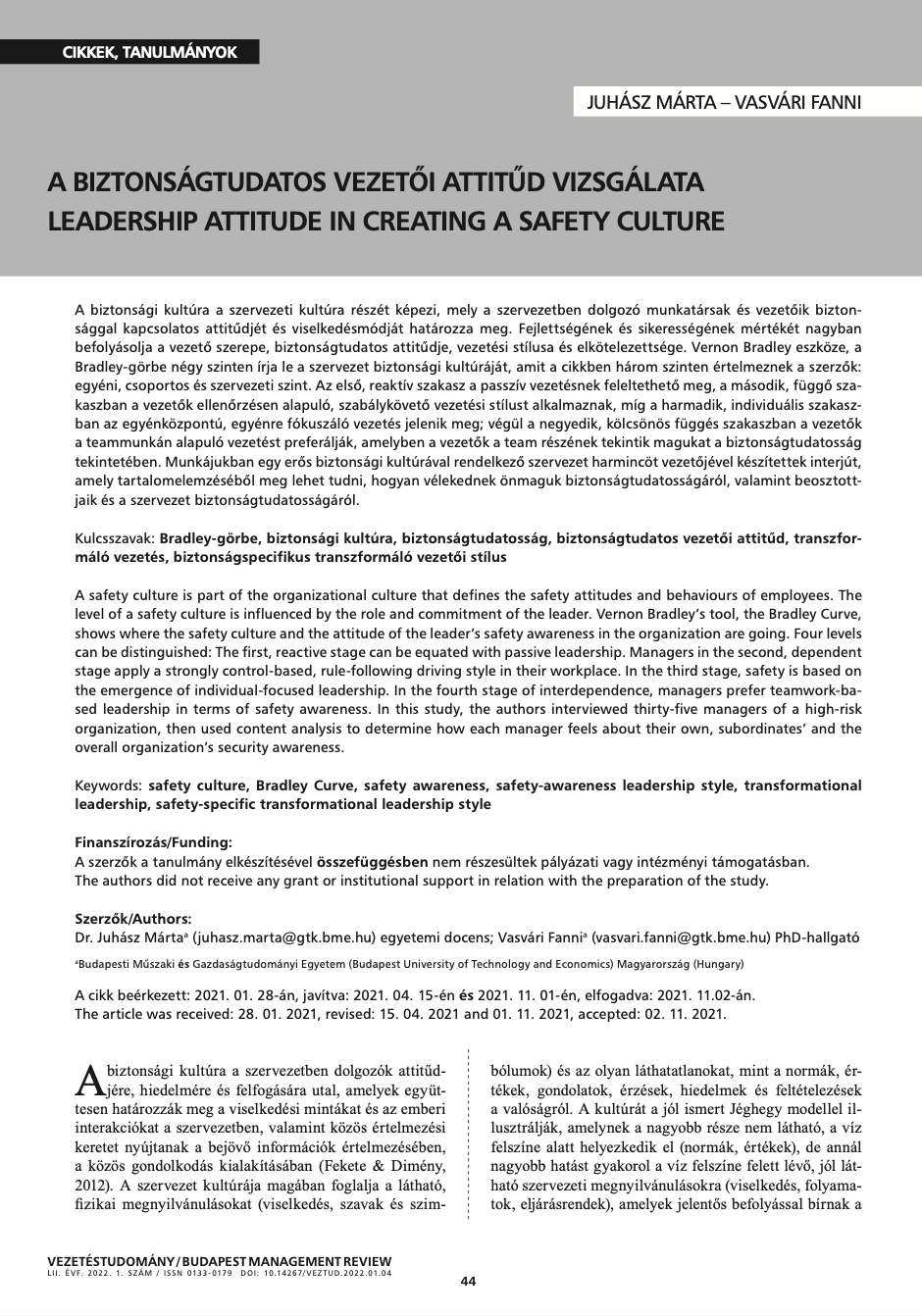A biztonságtudatos vezetői attitűd vizsgálata
DOI:
https://doi.org/10.14267/VEZTUD.2022.01.04Kulcsszavak:
biztonsági kultúra, Bradley-görbe, biztonságtudatosság, biztonságtudatos vezetői attitűd, transzformáló vezetés, biztonságspecifikus transzformáló vezetői stílusAbsztrakt
A biztonsági kultúra a szervezeti kultúra részét képezi, mely a szervezetben dolgozó munkatársak és vezetőik biztonsággal kapcsolatos attitűdjét és viselkedésmódját határozza meg. Fejlettségének és sikerességének mértékét nagyban befolyásolja a vezető szerepe, biztonságtudatos attitűdje, vezetési stílusa és elkötelezettsége. Vernon Bradley eszköze, a Bradley-görbe négy szinten írja le a szervezet biztonsági kultúráját, amit a cikkben három szinten értelmeznek a szerzők: egyéni, csoportos és szervezeti szint. Az első, reaktív szakasz a passzív vezetésnek feleltethető meg, a második, függő szakaszban a vezetők ellenőrzésen alapuló, szabálykövető vezetési stílust alkalmaznak, míg a harmadik, individuális szakaszban az egyénközpontú, egyénre fókuszáló vezetés jelenik meg; végül a negyedik, kölcsönös függés szakaszban a vezetők a teammunkán alapuló vezetést preferálják, amelyben a vezetők a team részének tekintik magukat a biztonságtudatosság tekintetében. Munkájukban egy erős biztonsági kultúrával rendelkező szervezet harmincöt vezetőjével készítettek interjút, amely tartalomelemzéséből meg lehet tudni, hogyan vélekednek önmaguk biztonságtudatosságáról, valamint beosztottjaik és a szervezet biztonságtudatosságáról.
Letöltések
Hivatkozások
Avolio, B.J., Bass, B.M., & Jung, D.I. (1999). Re-examining the components of transformational and transactional leadership using the Multifactor Leadership Questionnaire. Journal of Occupational and Organisational Psychology, 72(4), 441-462. https://doi.org/10.1348/096317999166789
Barling, J., Loughlin, C., & Kelloway, K. E. (2002). Development and Test of a Model Linking Safety-Specific Transformational Leadership and Occupational Safety. Journal of Applied Psychology, 87(3), 488–496. https://doi.org/10.1037/0021-9010.87.3.488
Bass, B. M. (1985). Leadership and performance beyond expectations. New York: Free Press.
Bass, B.M. (1990). From transactional to transformational leadership: learning to share the vision. Organisational Dynamics, 18(3), 19-31. https://doi.org/10.1016/0090-2616(90)90061-S
Bass, B.M., & Avolio, B.J. (1990). Transformational leadership development: Manual for the Multifactor Leadership Questionnaire. Palo Alto, CA: Consulting Psychologist Press.
Beveren, P., Dimas, I. D., Lourenco ̧ P. R., & Rebelo, T. (2017). Psychometric properties of the Portuguese version of the Global Transformational Leadership (GTL) scale. Journal of Work and Organizational Psychology, 33(2), 109–114. https://doi.org/10.1016/j.rpto.2017.02.004
Çalış, C., Büyükakıncı, B. Y. (2019). Leadership Approach in Occupational Safety: Taiwan Sample. Procedia Computer Science, 158, 1052–1057. https://doi.org/10.1016/j.procs.2019.09.146
Clarke, S. (2013). Safety leadership: a meta-analytic review of transformational and transactional leadership styles as antecedents of safety behaviours. Journal of Occupational and Organisational Psychology, 86(1), 22–49. https://doi.org/10.1111/j.2044-8325.2012.02064.x
Fekete, H., & Dimény, E. (2012). Megfelelő kultúra = kiváló teljesítmény? Vezetéstudomány, 43(4), 36–47. https://doi.org/10.14267/veztud.2012.04.04
Fenyvesi, Cs. (2016). A biztonsági kultúra megjelenése egy nukleáris erőmű mindennapjaiban. Gradus, 3(1), 23-37. https://gradus.kefo.hu/archive/2016-1/2016_1_ENG_002_Fenyvesi.pdf
Flin, R., & Yule, S. (2004). Leadership for safety: industrial experience. Qual Saf Health Care, 13(2), 45-51. http://dx.doi.org/10.1136/qshc.2003.009555
Fichtinger, Gy. (2015). A biztonsági kultúra felmérése és az eredmények hasznosítása nukleáris létesítményeknél. Budapest: Országos Atomenergetika Hivatal.
Israni, C. (2015). Correlation of Safety Leadership and Safety Culture. Mary Kay O’Connor Process Safety Center. 17th Annual International Symposium, College Station, TX.
Izsó, L., & Antalovits, M. (2006). Emberi tényezők az atomerőműben (Belső tanulmány). Paks– Budapest.
Jasiulewicz-Kaczmarek, M., Szwedzka, K., & Szczuka, M. (2015). Behaviour based intervention for occupational safety – case study. Procedia Manufacturing, 3, 4876 – 4883. http://dx.doi.org/10.1016/j.promfg.2015.07.615
Kegan, R. (1980). Making meaning: The constructive-developmental approach to persons and practice. The Personnel and Guidance Journal, 58(5), 373-380. https://doi.org/10.1002/j.2164-4918.1980.tb00416.x
Kegan, R. (1982). The evolving self: Problem and process in human development. Cambridge, MA: Harvard University Press.
Kegan, R. (1994). In Over Our Heads: The Mental Demands of Modern Life. Cambridge, MA: Harvard University Press.
Kegan, R., & Lahey, L. (1984). Adult leadership and adult development: A constructivist view. In B. Kellerman (Ed.), Leadership: Multidisciplinary Perspectives (pp. 199-229). New York: Prentice-Hall.
Kegan, R., & Lahey, L. (2009). Immunity to change: How to overcome it and unlock the potential in yourself and your organization. Boston, MA: Harvard Business School Press.
Kertai-Kiss, I. (2016). A kockázat- és bizonytalanságkezelés kérdései és a biztonsági kultúra. TAYLOR, 8(1), 151-59. https://ojs.bibl.u-szeged.hu/index.php/taylor/article/view/12994
Kelman, H. C. (1997). A szociális befolyásolás három folyamata. In Lengyel Zsuzsanna (Ed.), Szociálpszichológia. Szöveggyűjtemény (pp. 225-233). Budapest: Osiris Kiadó.
Knippenberg, D., Knippenberg, B. Cremer, D., & Hogg, M. A. (2004). Leadership, self, and identity: A review and research agenda. The Leadership Quarterly, 15(6), 825–856. https://doi.org/10.1016/j.leaqua.2004.09.002
Landy, F. J., & Conte, J. M. (2010). Work in the 21st Century: An Introduction to Industrial and Organisational Psychology. Hoboken, NJ: Wiley-Blackwell.
Lazányi, K. (2016). A biztonsági kultúra szerepe a vezetői döntések támogatásában. TAYLOR, 8(1), 143-50. https://ojs.bibl.u-szeged.hu/index.php/taylor/article/view/12993
Li, L., & Hovsepian, J.H. (2020). Safety culture development model. Professional Safety, 65(2), 53-54. https://doi.org/10.2118/201259-MS
Lord, R.G., Diefendorff, J.M., Schmidt, A.M., & Hall, R.J. (2010). Self-regulation at work. Annual Review of Psychology, 61, 543–568. https://doi.org/10.1146/annurev.psych.093008.100314
Mullen, J. E., & Kelloway, K. E. (2009). Safety leadership: A longitudinal study of the effects of transformational leadership on safety outcomes. Journal of Occupation- al and Organizational Psychology, 82(2), 253–272. https://doi.org/10.1348/096317908X325313
Mullen, J. E., Kelloway, K. E., & Teed, M. (2011). Inconsistent style of leadership as a predictor of safety behaviour. Work & Stress, 25(1), 41-54. https://doi.org/10.1080/02678373.2011.569200
Neal, A., & Griffin, M. A. (2002). Safety Climate and Safety Behaviour. Australian Journal of Management, 27(1 Suppl), 67-75. https://doi.org/10.1177/031289620202701S08
Neal, A., & Griffin, M. A. (2006). A Study of the Lagged Relationships Among Safety Climate, Safety Motivation, Safety Behavior, and Accidents at the Individual and Group Levels. Journal of Applied Psychology, 91(4), 946–953. https://doi.org/10.1037/0021-9010.91.4.946
Répáczki, R. (2014). A szakmai és a vezetői identitás alakulása fiatal felnőttkorban. A vezetői identitás alakulása a mentális komplexitás és a személyiség tükrében fiatal felnőtteknél (Doktori értekezés). Budapest: ELTE PPK.
Rudnák, I. (2010). A multikulturális környezet kihívásai a magyarországi nagyvállalatok vezetői körében (Doktori értekezés). Gödöllő: Szent István Egyetem Gazdálkodás- és Szervezéstudományi Doktori Iskola.
Schein, E. H. (1985). Organizational Culture and Leadership. San Francisco, CA: Jossey–Bass.
Skeepersa, N. C., & Mbohwa, C. (2015). A study on the leadership behaviour, safety leadership and safety performance in the construction industry in South Africa. Procedia Manufacturing, 4, 10-16. http://dx.doi.org/10.1016/j.promfg.2015.11.008
Szanyi-Gyenes, X., & Almási, A. (2021). A vezető szerepe a kis- és közepes vállalkozások sikerességében. Vezetéstudomány, 52(3), 40–52. https://doi.org/10.14267/VEZTUD.2021.03.04
Yukl, G. (1989). Managerial leadership: A review of theory and research. Journal of Management, 15(2), 251–289. https://doi.org/10.1177/014920638901500207

Downloads
Megjelent
Hogyan kell idézni
Folyóirat szám
Rovat
License
Copyright (c) 2022 Vezetéstudomány / Budapest Management Review

This work is licensed under a Creative Commons Attribution 4.0 International License.
Authors assign copyright to Vezetéstudomány / Budapest Management Review. Authors are responsible for permission to reproduce copyright material from other sources.

